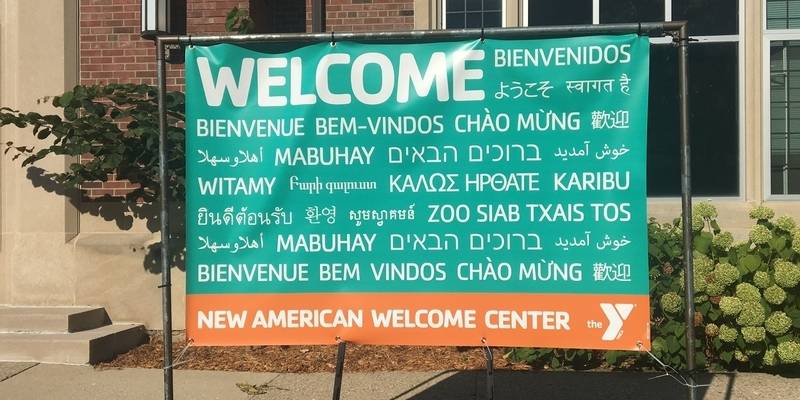The University YMCA, along with New American Economy, has released a Gateways for Growth Community Data report today, which details the contributions of immigrants in Champaign County (general take: they contribute a lot). Last year, the Y established a New American Welcome Center here, designed to help immigrants integrate fully into our community. We featured it here. Champaign-Urbana was also selected as one of 25 communities to receive the Gateways for Growth Challenge, an award which “is a combination of research, technical assistance, and/or matching grants awarded to communities that have demonstrated a public/private commitment to creating an environment that welcomes and includes all residents,” according to the YMCA.
There will be a community meeting this afternoon at the I-Hotel from 4 to 6 p.m. where the data report will be presented, followed by a panel discussion.
Infor from the press release is below, for the full report you can visit the YMCA website.
About the Gateways for Growth Community Data Report: The report is a customized, quantitative research report produced by data analysts at New American Economy and the New American Welcome Center. It sheds light on the contributions of immigrants to Champaign County’s population, labor force, and economy. On-the-ground technical assistance from NAE and Welcoming America will be provided under the local coordination of the University YMCA to help communities draft, execute, and communicate a multi-sector immigrant integration strategy.
“Champaign County’s schools and businesses get a major boost from talented, hard-working immigrants,” said John Feinblatt, President of New American Economy. “Immigration is a building block for economic growth, and welcoming newcomers only helps Champaign County sharpen its competitive edge over other growing regions.”
“We are hopeful that this report will catalyze greater awareness and collaboration, as we continue the work to make Champaign County an ever more welcoming and inclusive community,” said Mike Doyle, Executive Director of the University YMCA.
“A factual representation of the diverse immigrant population and their contributions in this area was long overdue. This report provides timely and relevant data towards creating an eventual “knowledge bank” so as to open up paths of empowerment and intercultural resolutions for immigrants through critical citizen engagement,” said Koeli Goel, Executive Committee Chair, Board of Trustees, Champaign Hindu Temple.
“Champaign County, particularly around the urban center here with the University and our international population, will benefit from programs that support immigrants and help them attain citizenship, jobs and self-reliance. Our employers are seeking trainable workers – this could be a good fit if we can help assimilate and train future employees to become part of our communities,” said Craig Rost, Executive Director Champaign County Economic Development Corporation.
“MTD promises and delivers mobility options for people of all backgrounds and abilities. We know that language and other barriers can impede access to our community, so we actively work to knock down those impediments. We are looking forward to using the data from this report to continue to learn and grow our offerings to those new to our country and community” -Amy Snyder, Customer Service Director, Champaign Urbana Mass Transit District.
Champaign County is home to one of the largest immigrant populations in Illinois outside of Chicagoland. In 2016, 1 in 10 county residents, 1 in 8 Champaign residents, and 1 in 5 Urbana residents were immigrants—joining our community from over 76 countries around the world. Our neighbors are from China and Mexico, Germany and India, Pakistan and the Philippines, Colombia and the Democratic Republic of the Congo. Champaign County was 1 of only 13 counties in Illinois with a growing population in 2016, in no small part thanks to immigrants.
Immigrants’ growing numbers have provided support to several key sectors. In STEM and Education, over 1 in 5 workers are immigrants. In manufacturing, hospitality, recreation, and healthcare, 1 in 10 workers are immigrants. In 2016 alone, local immigrants contributed 57 million dollars in local taxes, and injected hundreds of millions into our local economy. Immigrants fill needs at all levels of the county’s workforce, including in high-skilled sectors given that local immigrants are over 50 percent more likely than U.S.-born residents to hold a bachelor’s degree or higher.
“As an immigrant, I see my role in this community as a teacher at large. Champaign and Urbana are islands in the midst of a relatively closed cultural environment. The new immigrant population adds an ongoing conversation to areas of this community that refuse to see the full value added from education, commerce, culture and spirituality. At this current point in American history, immigrants play a role in educating the populace at large about the development of this society. We are all immigrants and the only peoples of this country are the indigenous people and to negate that is to refuse the historical facts and look to alternative facts. There is an accountability that we all owe each other, as we traverse this conversation and the biggest difficulty we have is the reality that the many that choose not to recognize immigration as a vital aspect of what this country, is will not participate in our conversations. So we should take this conversation to them and not remain in our ivory tower,” Joe Omo-Osagie, Board Member, Champaign County Mental Health Board and Counselor, Parkland Community College.








